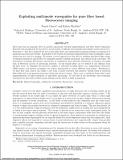Files in this item
Exploiting multimode waveguides for pure fibre based fluorescence imaging
Item metadata
| dc.contributor.author | Cizmar, Tomas | |
| dc.contributor.author | Dholakia, Kishan | |
| dc.contributor.editor | MahadevanJansen, A | |
| dc.contributor.editor | VoDinh, T | |
| dc.contributor.editor | Grundfest, WS | |
| dc.date.accessioned | 2014-09-19T09:31:02Z | |
| dc.date.available | 2014-09-19T09:31:02Z | |
| dc.date.issued | 2013-03-22 | |
| dc.identifier | 149507032 | |
| dc.identifier | a4a73a40-2c1f-4a46-8954-fde84655a7a5 | |
| dc.identifier | 000337082600017 | |
| dc.identifier | 84877844125 | |
| dc.identifier.citation | Cizmar , T & Dholakia , K 2013 , Exploiting multimode waveguides for pure fibre based fluorescence imaging . in A MahadevanJansen , T VoDinh & WS Grundfest (eds) , Advanced Biomedical and Clinical Diagnostic Systems XI . vol. 8572 , Proceedings of SPIE , vol. 8572 , SPIE , Bellingham , Conference on Advanced Biomedical and Clinical Diagnostic Systems XI , Canada , 3/02/13 . https://doi.org/10.1117/12.2003798 | en |
| dc.identifier.citation | conference | en |
| dc.identifier.issn | 0277-786X | |
| dc.identifier.uri | https://hdl.handle.net/10023/5453 | |
| dc.description | K. D. acknowledges support from EPSRC. | en |
| dc.description.abstract | There has been an immense drive in modern microscopy towards miniaturisation and fibre based technology. This has been necessitated by the need to access hostile or difficult environments particularly in-situ and in-vivo. Strategies to date have included the use of specialist fibres and miniaturised scanning systems accompanied by ingenious microfabricated lenses. In parallel recent studies of randomized light fields and their holographic control opened up new ways for imaging. We present a novel approach for this field by utilising disordered light within a standard multimode optical fibre for minimally invasive lensless microscopy and optical mode conversion. We demonstrate scanning fluorescence microscopy at acquisition rates allowing observation of dynamic processes such as Brownian motion of mesoscopic particles. As the sample plane can be defined at any distance from the fibre facet, we eliminate the need for complex or elaborate focusing optics (e.g. miniaturized objectives, GRIN lenses) and instead reconfigure the system dynamically to image different axial planes. Furthermore, we show how such control can realise a new form of mode converter and generate various types of advanced light fields such as propagation-invariant beams and optical vortices. These may be useful for future fibre based implementations of super-resolution or light sheet microscopy. To the best of our knowledge, this technology represents the narrowest possible image guiding system based on light propagation. | |
| dc.format.extent | 7 | |
| dc.format.extent | 768024 | |
| dc.language.iso | eng | |
| dc.publisher | SPIE | |
| dc.relation.ispartof | Advanced Biomedical and Clinical Diagnostic Systems XI | en |
| dc.relation.ispartofseries | Proceedings of SPIE | en |
| dc.subject | Digital holography | en |
| dc.subject | Multimode waveguides | en |
| dc.subject | Fluorescence | en |
| dc.subject | Microscopy | en |
| dc.subject | Light | en |
| dc.subject | Resolution | en |
| dc.subject | QC Physics | en |
| dc.subject | R Medicine (General) | en |
| dc.subject.lcc | QC | en |
| dc.subject.lcc | R1 | en |
| dc.title | Exploiting multimode waveguides for pure fibre based fluorescence imaging | en |
| dc.type | Conference item | en |
| dc.contributor.institution | University of St Andrews. School of Medicine | en |
| dc.contributor.institution | University of St Andrews. School of Physics and Astronomy | en |
| dc.contributor.institution | University of St Andrews. Biomedical Sciences Research Complex | en |
| dc.identifier.doi | https://doi.org/10.1117/12.2003798 |
This item appears in the following Collection(s)
Items in the St Andrews Research Repository are protected by copyright, with all rights reserved, unless otherwise indicated.

